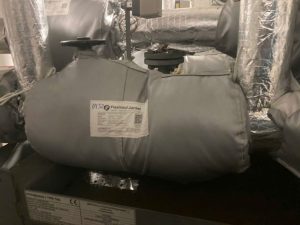Heat loss from piping systems, valves, and machinery is a persistent energy cost challenge for many factories. However, this is a completely controllable waste. A real-world case study shows that installing 200 custom insulation jackets helped a factory cut its energy consumption by up to 30%, proving the outstanding effectiveness of this solution in optimizing operations.
The Heat Loss Problem: The “Silent Enemy” of Every Factory
In an industrial environment, maintaining stable temperatures for systems is a key factor in ensuring production. Yet, heat loss from valves, joints, and machine bodies occurs daily.
Using traditional insulation methods (like hand-wrapped fiberglass) or leaving heat-radiating surfaces exposed not only wastes energy but also poses several risks:
- Soaring operating costs: Higher electricity, gas, and steam bills as the system must run continuously to compensate for lost heat.
- Workplace safety hazards: Hot equipment surfaces can reach hundreds of degrees Celsius, posing a serious burn risk to workers.
- Environmental impact: Higher energy consumption means increased carbon emissions.
- Reduced equipment lifespan: Machinery that constantly runs over capacity will wear out and fail more quickly.
The Practical Solution: Deploying 200 Custom Insulation Jackets
To definitively solve the problem, the factory management decided to deploy a system of custom-fit insulation jackets (also known as insulation blankets). The project focused on the 200 locations with the highest risk of heat loss, including:
- Globe, ball, and gate valve assemblies.
- Flanges and joints on steam and hot oil pipelines.
- The bodies of plastic injection molding machines, extruders, and other heating equipment.
Unlike permanent insulation, these insulation jackets are designed and tailored for each specific location, allowing for easy removal and re-installation in minutes. This is extremely useful for routine maintenance without damaging the insulation layer.
Construction and Operating Principle
Insulation jackets typically have a smart 3-layer construction to optimize thermal insulation and durability:
- Outer layer: High-temperature resistant fabric that is waterproof, chemical-resistant, and flame-retardant, ensuring durability in harsh industrial environments.
- Middle layer: The core insulation material (ceramic fiber, mineral wool, aerogel) with an extremely low thermal conductivity, tasked with preventing heat from escaping.
- Inner layer: Heat-resistant fabric that is in direct contact with the equipment surface.
- Fasteners: Specialized straps and buckles that secure the jacket firmly to the equipment while still allowing for flexible removal.
Results Beyond Expectations: A 30% Reduction in Energy Costs and More
After a period of implementation and measurement, the results proved this was a sound investment decision.
Economic Benefits
- 30% reduction in energy costs: The retained heat allowed the heating system to operate less frequently, directly and significantly cutting monthly energy bills.
- Fast return on investment (ROI): With impressive savings, the initial investment in the insulation jacket system was paid back in a short period.
- Reduced maintenance costs: The ease of removal and re-installation saves time and labor during each maintenance cycle, eliminating the cost of re-insulating as with traditional methods.
Operational & Safety Benefits
- Absolute safety: The surface temperature of the insulation jackets remains at a safe level (<60°C), completely eliminating the risk of burns.
- Improved working environment: The ambient temperature in the installation areas decreased, creating a cooler, more comfortable workspace for employees.
- Equipment protection: The insulation jacket acts as a protective shield, safeguarding equipment from external environmental impacts and helping to extend its lifespan.
Lessons Learned: Insulation Jackets are a Strategic Investment
This case study demonstrates that an insulation jacket is not just a simple insulation solution but a strategic investment. It helps businesses simultaneously solve challenges related to cost optimization, workplace safety enhancement, and contributions to sustainable development goals.
If your factory is facing heat loss issues, consider insulation jackets as a solution to start saving today.
Request consultation and quotation now!Frequently Asked Questions
What is an insulation jacket?
An insulation jacket is a type of removable thermal cover designed for easy installation and removal on valves, pipes, and machinery in factories to reduce heat loss and improve safety.
How do insulation jackets help save energy?
By preventing heat from escaping into the environment, insulation jackets help heating systems operate less frequently to compensate for heat loss, thereby significantly reducing the consumption of electricity, gas, or steam.
Is installing an insulation jacket complicated?
Not at all. Insulation jackets are custom-made for each piece of equipment and come with smart straps and buckles, making installation and removal take only a few minutes without needing specialized tools.
What is the return on investment (ROI) time for insulation jackets?
The payback period is often quite fast, potentially ranging from only 6-18 months, depending on the operating temperature, energy costs, and the scale of the system.
What types of equipment can insulation jackets be used for?
Insulation jackets can be designed for almost any equipment that requires heat retention, such as: valves, flanges, pipes, plastic injection molding machines, extruders, boilers, tanks, and many other types of industrial machinery.
Are insulation jackets durable in a factory environment?
Yes, insulation jackets are made from specialized materials that are waterproof, chemical-resistant, can withstand high temperatures and impacts, ensuring long-term durability.










